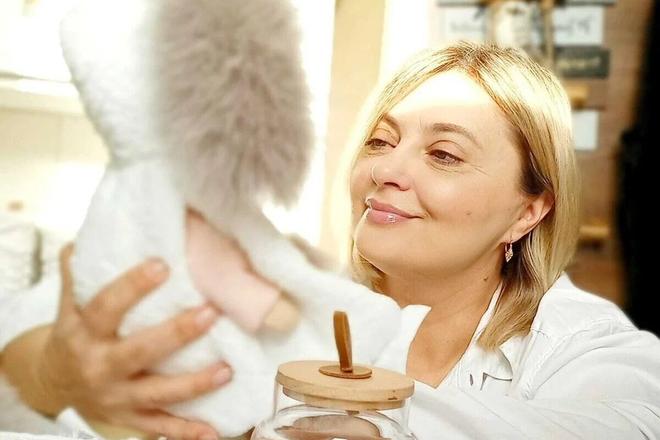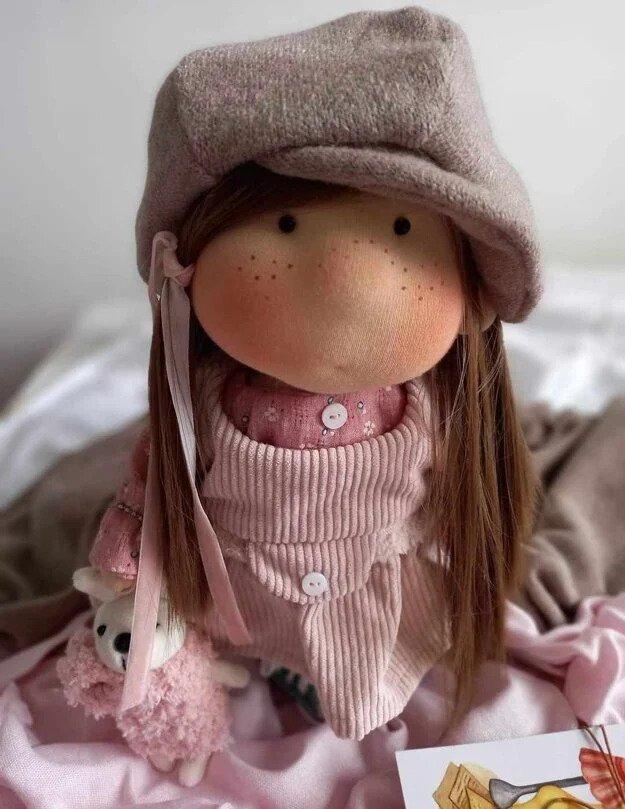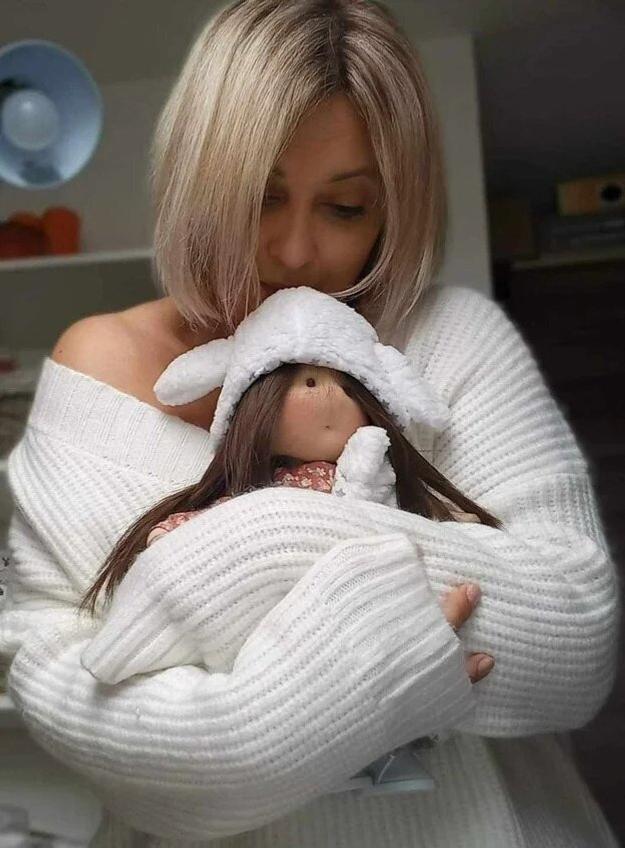Ukrainian version | Slovak version
Svetlana Martynovskaya, a middle-aged Ukrainian dollmaker, has one simple rule that she always follows before she picks up the needle: If she’s not in a good mood, she never sews.
“It’s because I pass all my emotions on to the rag doll,” she explains. “And I’d like the child or grown-up who buys my doll to feel my positive energy.”
She does not perceive any of the rag dolls that the Ukrainian has ever made as a thing. In fact, she doesn’t even say that she sews dolls. Instead, the artist prefers to describe it as ‘giving birth’ to dolls. To her, every doll she makes is a character with a soul.
Martynovskaya, a mother of two, has loved dolls since she was a little girl. She played with and sewed clothes for them. It was indeed a matter of time before she developed a great liking for sewing and make her first toy. The talent seems to be in the family. Martynovskaya’s mother used to sew and knit, and her sister has also been knitting for a long time. In addition, she also learned how to sew in school.
At Christmas, when their family house was traditionally decorated with toys, she decided to make her first sewn toy. It was supposed to be a moose. But it turned out to be a Christmas angel in the style of a whimsical Tilda character (a rag doll produced by the Norwegian fabric brand Tilda).
“It may not have been perfect. Yet, it was a real ‘wow’ for everyone,” the Ukrainian recalls.
She rediscovered the craft of sewing dolls during her pregnancy 13 years ago. Since then, she has been improving her techniques. Martynovskaya has made around 400 rag dolls to date. Each is different, the dollmaker says. What she can’t quantify is how much time she spent on those 400 dolls, as she says she loses herself in space and time when sewing them.
“Thanks to the dolls, I’ve extended my childhood,” Martynovskaya says about her hobby.
From Voznesensk to Trenčín
Over the years, her dolls have found new homes in many countries. Even in Slovakia where she and her teenage son, Nikita, fled from Voznesensk, a town of 33,000 near Odessa, a month after Russia invaded Ukraine last February.
Following the invasion, at first Martynovskaya continued going to work and tried to help Ukrainian soldiers. But after they survived a heavy shelling in early March, they found themselves standing in the middle of a destroyed yard and realised that they didn’t know what to do next. Grocery stores were nearly empty, people were leaving the town, and Martynovskaya feared that her son would go hungry.
“This was the moment when I realised that I myself was responsible for my family. Just me,” the Ukrainian mother says. “I thought that I’m a mother more than a citizen. I gave life to this child, I have to save it.”
Because her son is a swimmer, they were first offered to moving to Germany where he could continue swimming. But free places had run out before she and her son made a decision. In the end, they agreed to move to Slovakia. They arrived in the country with one suitcase. Apart from documents, tracksuits and Nikita’s swimming clothing, Martynovskaya managed to pack her favourite sewing patterns into the suitcase at the last minute.
After a stay in a camp for refugees, they moved to Púchov, a town in western Slovakia, where Nikita joined a local swimming team, Matador. The Slovak swimming community has provided temporary shelter to more than 100 swimmers from Ukraine.
“You probably won't believe this, but we initially lived in the local fire department with firefighters,” the Ukrainian recalls. “We slept on benches. It was a difficult time, but an interesting one.”
Later, they got a place in a dormitory. Simultaneously, Martynovskaya, a former cashier, began to work for the KMF machine shop in the neighbouring city of Trenčín to get by. She had to wake up at three in the morning to reach work by train before they had the chance to move to Trenčín.
“At first, I didn’t understand what I could do there since this field was unfamiliar to me.”
But the Ukrainian mother has seen the experience as a task rather than a problem: ‘Hey, Svetlana. How will you cope with this task?” Her creative thinking, she says, has always helped her in such situations. She adds that she always looks for the positive, because only the positive has always helped her.
Today, her son swims for the Slávia club in Trenčín, is fluent in Slovak and studies at a local school. Martynovskaya herself was well-received by her colleagues. She says that they were even interested in buying her rag dolls, which are made from the White Angel fabric for doll-making, as soon as she showed them pictures.
“When orders from Slovaks started to come in, I realised that I had nothing to sew them with,” recalls the Ukrainian.
Like many years ago in Ukraine, she had to buy threads, fabrics, scissors and needles. The sewing machine was a gift. Despite her circumstances, she hasn’t given up on dreaming.
“I dream very much about my own workshop where a person can come in and see how a doll is created,” the Ukrainian reveals.
And if you are wondering about the names of th dolls made by the Ukrainian artist, there are none. She thinks it’s not right for her to give them names. She leaves it up to its owner.
Becoming calm
Almost two years into her stay in Slovakia, she says that the country is beautiful and very friendly. She also appreciates the fact that children in Slovakia, unlike children in Ukraine, are not pressured to excel in school and deliver excellent results in their after-school activities.
The Ukrainian admires that Slovak people forget about work at the weekend and focus on their families, too.
“I’ve learned to be calm, accept everything as it is and not to rush,” Martynovskaya notes.
Her priority is still her son and his well-being. She doesn’t know what her life in Ukraine would be like if they were to return home, but the mother knows that her son doesn’t have to have any fear in Slovakia.
“It's said that every mother should give her child peace, a carefree childhood,” she says.
Her son, Nikita, and children in general inspire her when she creates dolls in her free time. She says that she wants to teach them that they don’t have to give up, even if their situation looks difficult or like they may lose everything. In addition, as she goes on to say, knowledge is something that cannot be taken away from anyone.
In those two years, she herself has learned not to plan things for the future as nobody knows what the future holds for them.
“Maybe tomorrow my dream will come true. I will have my own workshop and I will do what pleases me.”
This story was published with support from the International Press Institute's Ukraine regional reporting fund.




 Svetlana Martynovskaya. (source: Archive of S. M.)
Svetlana Martynovskaya. (source: Archive of S. M.)
 (source: Archive of S. M.)
(source: Archive of S. M.)
 (source: Archive of S. M.)
(source: Archive of S. M.)